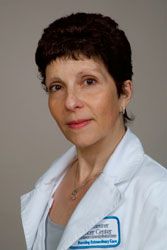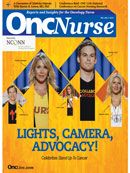Publication
Article
Oncology Nursing News
Nurse's Insight: An Interview With JTCC Advanced Practice Nurse Laura Metcalfe
Author(s):
As part of the Intellisphere Oncology Specialty Group's new partnership with the John Theurer Cancer Center (JTCC), our online and print coverage will provide special insight from JTCC's oncology healthcare professionals

Laura Metcalfe, MSN, RN, APN, C, AOCNS
As part of the Intellisphere Oncology Specialty Group’s new partnership with the John Theurer Cancer Center (JTCC), our online and print coverage will provide special insight from JTCC’s oncology healthcare professionals. This coverage will include interviews discussing cancer treatment and care, along with updates on developments at the JTCC. Many of the interviews will be filmed live at the JTCC and appear on OncLive TV, our new online video platform. This month, OncLive Nursing discusses gastrointestinal cancer and general cancer-related topics with Advanced Practice Nurse Laura Metcalfe, MSN, RN, APN, C, AOCNS.
OncLive Nursing: What are the current recommendations concerning the age at which an individual should get a colonoscopy?
Metcalfe:The guidelines say you [should] start at age 50, assuming you have no risk factors for colorectal cancer. Obesity, inactivity, the Western diet—high in red meat, high in fat, low in fiber and fruits and vegetables— those are the modifiable risk factors [for colorectal cancer. There are also] risk factors that aren’t modifiable—age, family history, or [a personal history of]…any inflammatory bowel disease.
We’re seeing a lot of patients in their 70s and 80s who have never had a colonoscopy. And now, all of a sudden, some symptom develops—they get obstructed—and they wind up in the emergency room [having] surgery for colon cancer. Well, had they had a colonoscopy 20 years earlier, this might not have happened.
In October 2010, the FDA approved trastuzumab (Herceptin) for treatment of patients with gastric cancer. Is the treatment being used at the JTCC and, if so, what is your experience with trastuzumab?
We see a lot of patients with gastric cancers or gastroesophageal junction, which is where the esophagus meets the stomach, so we sort of treat them the same way. We now routinely test all their tumors for HER2/neu, which is the marker that will be overexpressed. I think it’s a small percentage of the patients with gastric cancer who will be positive. But if they are, we will definitely add Herceptin into their regimen. And it’s only probably been within the last 6 months, maybe a year, that we’re adding—I think it’s a year—that we’re doing this. But it definitely, in studies, was shown to improve disease-free survival.
[Trastuzumab] does have some potential side effects—some cardiac potential side effects—so we always check people’s heart function before we give it to them. And there may be a time you might have to stop the drug for a while if [the patient’s] heart function lessens. But other than that, because it’s not chemotherapy, per se, [trastuzumab] doesn’t cause nausea or hair loss or a lot of the other side effects associated with chemotherapy. So patients are usually kind of happy to get it, especially if it can help them without too many side effects, other than the cardiac issue.
"We have social workers [and] we really try to have them see every newly-diagnosed patient."
What are some of the emotional and psychological side effects your patients experience and how do you address them? Are there staff members available at the JTCC who can help patients with these issues?
Well, everyone who comes in knows they have cancer—whether they were told the day before, or whether they were already aware of it for a couple of weeks. They’re still usually pretty much in a state of shock.
We have social workers [and] we really try to have them see every newly-diagnosed patient, but certainly those who we can see are struggling. Sometimes the [patient’s] family needs help. One of our social workers—well she’s actually a psychiatric clinical nurse specialist—she has groups for children, because sometimes it’s hard for the children to see their mother losing hair or the physical changes that can accompany [cancer treatment].
Sometimes that’s even harder than the diagnosis or the treatment—the physical changes that are almost like a beacon to the world that “I’m on chemotherapy.” I’ve had women tell me that actually losing a breast was less traumatic than losing their hair, because not everyone can see [that you’ve lost a breast]. Some people also lose their eyebrows and eyelashes, so it’s not even just a matter of putting a wig on.
Skin color [can also] change. A lot of the pancreatic patients or gastric cancer patients wind up with a lot of jaundice and ascites…But, again, we do have social workers that will definitely hook up with them and try to help them learn to deal with [all of these symptoms] as best as possible.
Over the past several years, have you witnessed an increase in patient use of complementary therapies?
I think [patients] have always used [these treatments], but I think they may be a little more upfront about it now, or maybe we even ask more about it now. There are some therapies that we would wholeheartedly endorse. We’ve sent patients for acupuncture for refractory nausea, different problems that don’t respond to traditional medicine.
But some of these herbal supplements that patients want to take can actually interfere with the chemo or affect their liver. So we try to bring it up out of the gate. We ask patients what they are taking so that we can have our pharmacist take a look at everything and look at what chemo drugs they’re on.
[For example,] the same enzymes in the liver metabolize St. Johns wort. That’s one that usually you can never take with chemo or CoQ10 and the chemo. You can’t take [them] because they could be inhibitors of the drug, make you have more drug in your system, or they could suppress it, and you could have less drug in your system.
So the general rule we try to tell patients [is that something such as] a multivitamin is okay but none of these megadoses of vitamins. For example, everybody thinks antioxidants are good. Well, maybe they are for you or me, but no one has done this study. No one’s taken 100 patients, given 50 [of them] high-dose antioxidants along with chemotherapy and 50 [of them] no antioxidants along with chemotherapy to see if there is a problem. And no one is going to do that study, let’s be honest. But if the theory of antioxidants is that they protect cells from free radicals or damage, well, we certainly don’t want to protect cancer cells from the damage we’re trying to inflict with the chemotherapy. So it just seems counterintuitive for people to be taking high-dose antioxidants. [And yet] people come in with bags full [saying], “I take these 20 pills before breakfast, and this is good for my immune system, and this cleans my liver, and my neighbor had cancer and took 2 of these pills and it went away.” And [a lot of this stems from misinformation] on the Internet.
I try to always caution my patients. Go on the Internet. I know you’re going to, that’s fine. I’m sure I would. Just know your source. If you’re looking up cancer information, go to Memorial Sloan Kettering. Go to the National Cancer Institute, MD Anderson, any big cancer center. Don't just believe what someone puts out there— some miracle story. It's the Acai berry [diet] this year. It was the Noni juice... last year. It's sad because it's a vulnerable population...So we try to keep the subject [of complementary therapy] out there so patients don’t feel like they have to hide it from us…Patients could be doing themselves more harm than good, so we try to keep it open.
“ We try to keep the subject [of complementary therapy] out there so patients don’t feel like they have to hide it from us.”
You brought up patient use of the Internet. Have e-Patients made your job more or less difficult?
Probably a little bit of both. Some people get factual information. They’re well informed. They come in [and] they kind of already understand the process—they almost anticipate what treatment you’re going to tell them. Say FOLFOX is the standard of care. You say FOLFOX [and the patient says], “Oh, FOLFOX, okay.” And that’s good, and then they don’t doubt that they’re getting the best therapy.
But [with] these other testimonials [available] from whatever quack is putting stuff out there, [patients]…come in with all this [and] it can be hard. Because I don’t want to say they don’t believe you, but I think there’s still that doubt, like, “Why are you not telling me about this juice that could cure me or this berry or plant.” And I don’t know what they [are doing] in their [own homes]. You can only tell them medically what’s advisable and if they use it, they use it.
How is the new John Theurer facility helpful for you and for your patients?
Well, [in our previous facility] exam rooms…were very limited. So, for example, if the doctor saw the patient and then I needed to talk to them either before or after…to go over side effects of chemo or talk to their family, we had no place to do that because the doctor needed the patient out of the room for him to see the next patient. So it was always trying to find [someplace to talk with the patient that was] conducive to learning, to privacy.
Now patients are saying [about the new facility], “It’s so big.” [The new building] has a lot of features for the patients. They have a meditation room. It’s just a beautiful building. I just think it’s a much more calming environment than our last facility was, only because we were so crowded. [If] you walk into a waiting room and see hundreds of people, already your stress level goes up just thinking, “How long is my wait going to be.” Before, 12 doctors were seeing…patients out of the same waiting room…Now we have doctors on [different] floors, so you don’t come into that mass wait like before. So I think the flow is better. And...we’re getting compliments from the patients.










